University Healthcare Report: mHealth & Diabetes Self-Management
VerifiedAdded on 2020/05/16
|7
|1796
|433
Report
AI Summary
This report investigates the effectiveness of mHealth support groups in enhancing diabetes self-management education within a home healthcare context. The study utilizes Imogene King's Goal Attainment Theory to explore the interpersonal dynamics between patients and healthcare professionals, emphasizing the importance of setting and achieving individual goals. The report details the application of this theory, highlighting how mHealth can facilitate communication, support patient education, and improve medication adherence, self-monitoring of blood glucose, and overall lifestyle modifications. It also analyzes the strengths and limitations of King's theory, emphasizing the need for adapting the communication process between nurses and patients for optimal outcomes. The findings suggest that by addressing the patient's personal system, healthcare providers can motivate and empower individuals to actively participate in their diabetes care, ultimately leading to improved health outcomes. This report is a valuable resource for healthcare professionals and students alike, offering insights into the integration of technology and nursing theory to improve patient care.
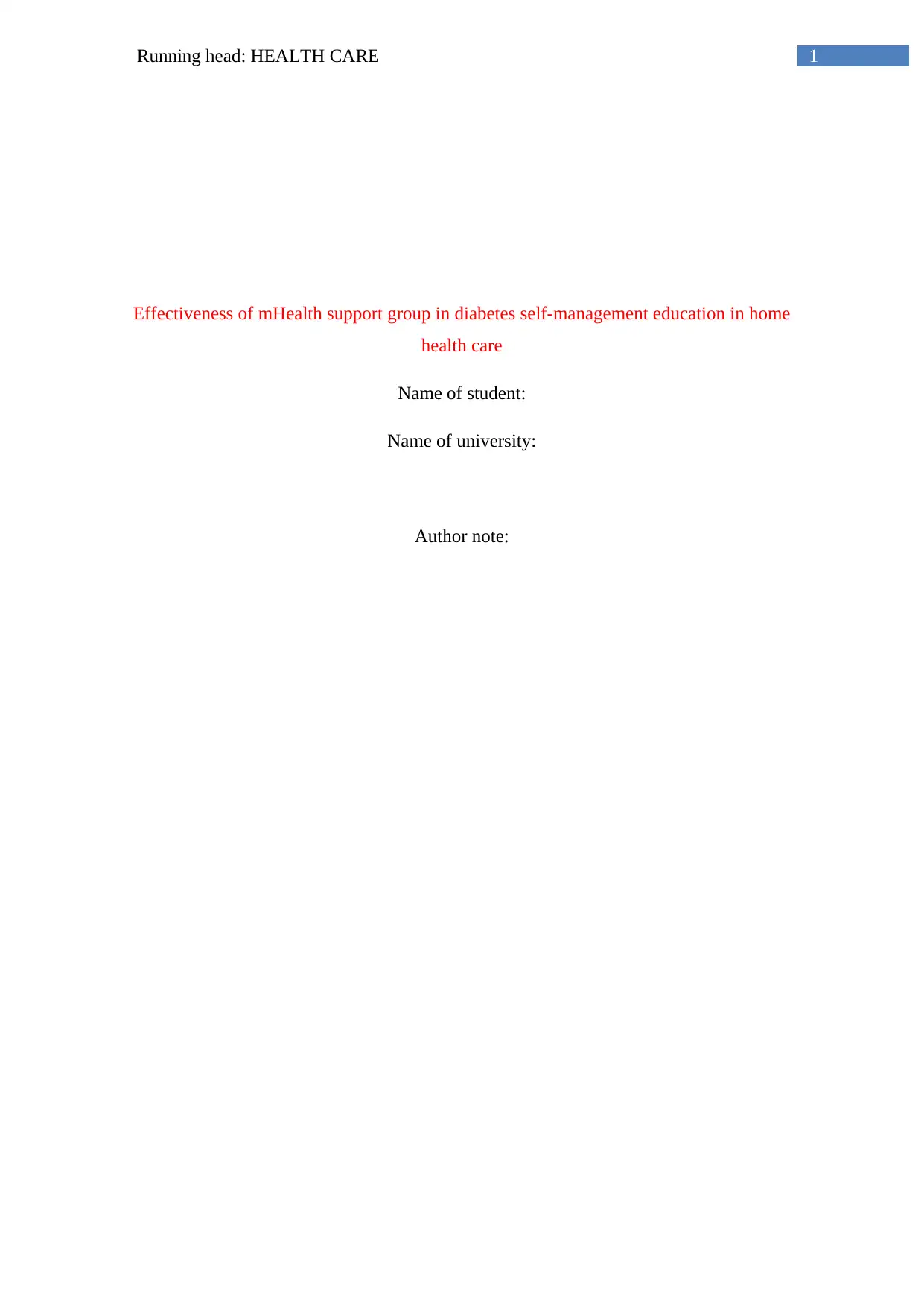
1Running head: HEALTH CARE
Effectiveness of mHealth support group in diabetes self-management education in home
health care
Name of student:
Name of university:
Author note:
Effectiveness of mHealth support group in diabetes self-management education in home
health care
Name of student:
Name of university:
Author note:
Paraphrase This Document
Need a fresh take? Get an instant paraphrase of this document with our AI Paraphraser
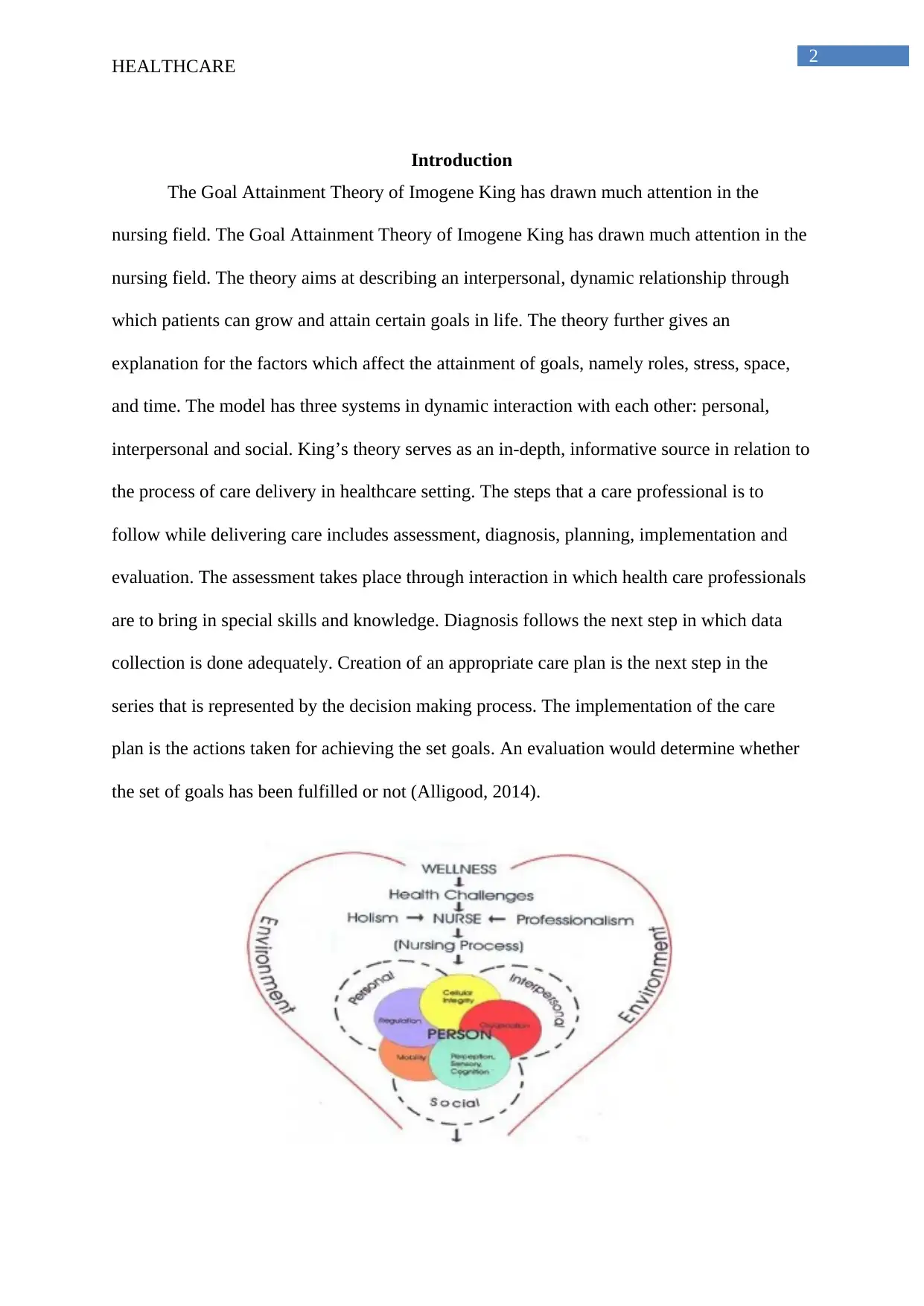
2
HEALTHCARE
Introduction
The Goal Attainment Theory of Imogene King has drawn much attention in the
nursing field. The Goal Attainment Theory of Imogene King has drawn much attention in the
nursing field. The theory aims at describing an interpersonal, dynamic relationship through
which patients can grow and attain certain goals in life. The theory further gives an
explanation for the factors which affect the attainment of goals, namely roles, stress, space,
and time. The model has three systems in dynamic interaction with each other: personal,
interpersonal and social. King’s theory serves as an in-depth, informative source in relation to
the process of care delivery in healthcare setting. The steps that a care professional is to
follow while delivering care includes assessment, diagnosis, planning, implementation and
evaluation. The assessment takes place through interaction in which health care professionals
are to bring in special skills and knowledge. Diagnosis follows the next step in which data
collection is done adequately. Creation of an appropriate care plan is the next step in the
series that is represented by the decision making process. The implementation of the care
plan is the actions taken for achieving the set goals. An evaluation would determine whether
the set of goals has been fulfilled or not (Alligood, 2014).
HEALTHCARE
Introduction
The Goal Attainment Theory of Imogene King has drawn much attention in the
nursing field. The Goal Attainment Theory of Imogene King has drawn much attention in the
nursing field. The theory aims at describing an interpersonal, dynamic relationship through
which patients can grow and attain certain goals in life. The theory further gives an
explanation for the factors which affect the attainment of goals, namely roles, stress, space,
and time. The model has three systems in dynamic interaction with each other: personal,
interpersonal and social. King’s theory serves as an in-depth, informative source in relation to
the process of care delivery in healthcare setting. The steps that a care professional is to
follow while delivering care includes assessment, diagnosis, planning, implementation and
evaluation. The assessment takes place through interaction in which health care professionals
are to bring in special skills and knowledge. Diagnosis follows the next step in which data
collection is done adequately. Creation of an appropriate care plan is the next step in the
series that is represented by the decision making process. The implementation of the care
plan is the actions taken for achieving the set goals. An evaluation would determine whether
the set of goals has been fulfilled or not (Alligood, 2014).
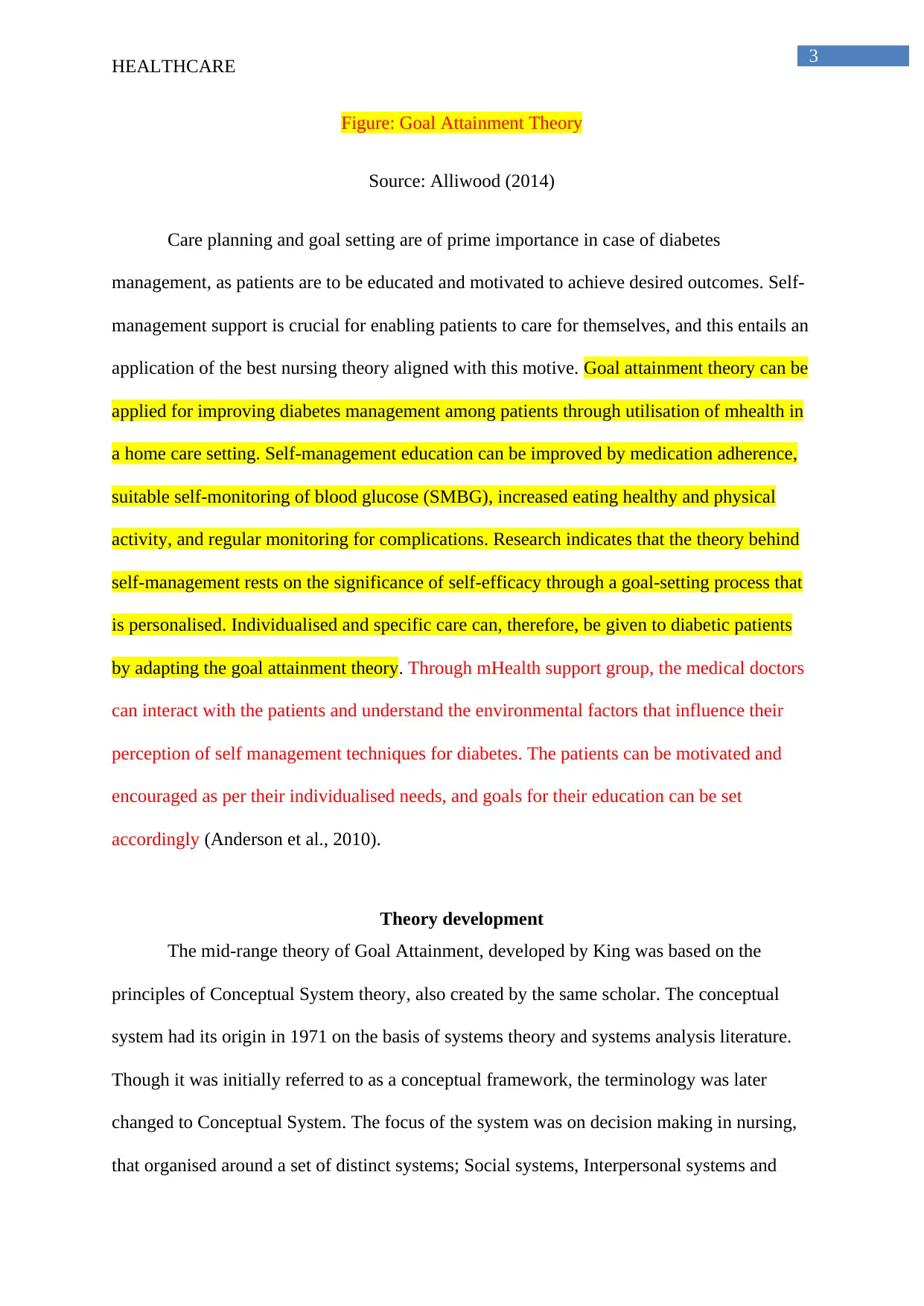
3
HEALTHCARE
Figure: Goal Attainment Theory
Source: Alliwood (2014)
Care planning and goal setting are of prime importance in case of diabetes
management, as patients are to be educated and motivated to achieve desired outcomes. Self-
management support is crucial for enabling patients to care for themselves, and this entails an
application of the best nursing theory aligned with this motive. Goal attainment theory can be
applied for improving diabetes management among patients through utilisation of mhealth in
a home care setting. Self-management education can be improved by medication adherence,
suitable self-monitoring of blood glucose (SMBG), increased eating healthy and physical
activity, and regular monitoring for complications. Research indicates that the theory behind
self-management rests on the significance of self-efficacy through a goal-setting process that
is personalised. Individualised and specific care can, therefore, be given to diabetic patients
by adapting the goal attainment theory. Through mHealth support group, the medical doctors
can interact with the patients and understand the environmental factors that influence their
perception of self management techniques for diabetes. The patients can be motivated and
encouraged as per their individualised needs, and goals for their education can be set
accordingly (Anderson et al., 2010).
Theory development
The mid-range theory of Goal Attainment, developed by King was based on the
principles of Conceptual System theory, also created by the same scholar. The conceptual
system had its origin in 1971 on the basis of systems theory and systems analysis literature.
Though it was initially referred to as a conceptual framework, the terminology was later
changed to Conceptual System. The focus of the system was on decision making in nursing,
that organised around a set of distinct systems; Social systems, Interpersonal systems and
HEALTHCARE
Figure: Goal Attainment Theory
Source: Alliwood (2014)
Care planning and goal setting are of prime importance in case of diabetes
management, as patients are to be educated and motivated to achieve desired outcomes. Self-
management support is crucial for enabling patients to care for themselves, and this entails an
application of the best nursing theory aligned with this motive. Goal attainment theory can be
applied for improving diabetes management among patients through utilisation of mhealth in
a home care setting. Self-management education can be improved by medication adherence,
suitable self-monitoring of blood glucose (SMBG), increased eating healthy and physical
activity, and regular monitoring for complications. Research indicates that the theory behind
self-management rests on the significance of self-efficacy through a goal-setting process that
is personalised. Individualised and specific care can, therefore, be given to diabetic patients
by adapting the goal attainment theory. Through mHealth support group, the medical doctors
can interact with the patients and understand the environmental factors that influence their
perception of self management techniques for diabetes. The patients can be motivated and
encouraged as per their individualised needs, and goals for their education can be set
accordingly (Anderson et al., 2010).
Theory development
The mid-range theory of Goal Attainment, developed by King was based on the
principles of Conceptual System theory, also created by the same scholar. The conceptual
system had its origin in 1971 on the basis of systems theory and systems analysis literature.
Though it was initially referred to as a conceptual framework, the terminology was later
changed to Conceptual System. The focus of the system was on decision making in nursing,
that organised around a set of distinct systems; Social systems, Interpersonal systems and
⊘ This is a preview!⊘
Do you want full access?
Subscribe today to unlock all pages.

Trusted by 1+ million students worldwide
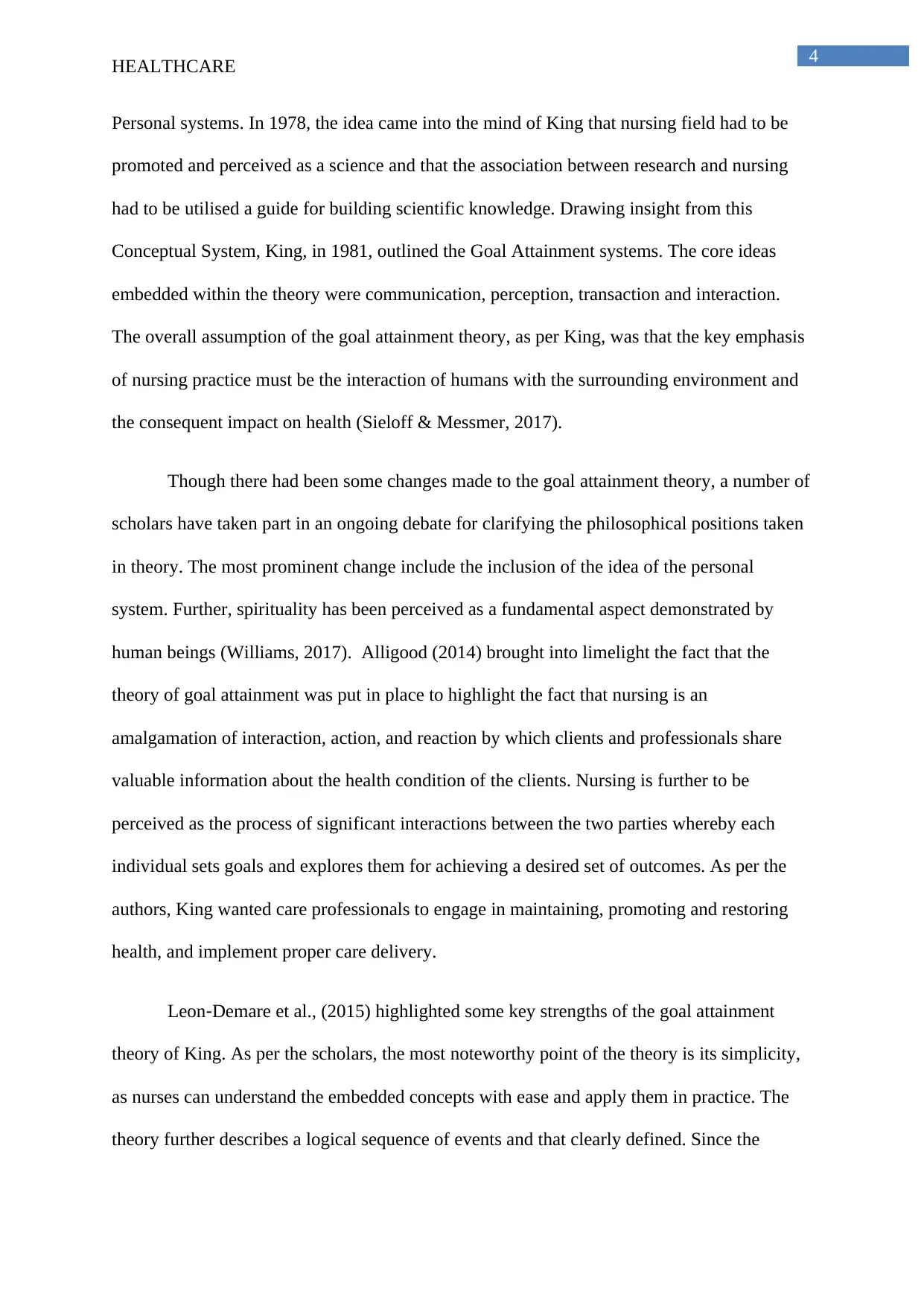
4
HEALTHCARE
Personal systems. In 1978, the idea came into the mind of King that nursing field had to be
promoted and perceived as a science and that the association between research and nursing
had to be utilised a guide for building scientific knowledge. Drawing insight from this
Conceptual System, King, in 1981, outlined the Goal Attainment systems. The core ideas
embedded within the theory were communication, perception, transaction and interaction.
The overall assumption of the goal attainment theory, as per King, was that the key emphasis
of nursing practice must be the interaction of humans with the surrounding environment and
the consequent impact on health (Sieloff & Messmer, 2017).
Though there had been some changes made to the goal attainment theory, a number of
scholars have taken part in an ongoing debate for clarifying the philosophical positions taken
in theory. The most prominent change include the inclusion of the idea of the personal
system. Further, spirituality has been perceived as a fundamental aspect demonstrated by
human beings (Williams, 2017). Alligood (2014) brought into limelight the fact that the
theory of goal attainment was put in place to highlight the fact that nursing is an
amalgamation of interaction, action, and reaction by which clients and professionals share
valuable information about the health condition of the clients. Nursing is further to be
perceived as the process of significant interactions between the two parties whereby each
individual sets goals and explores them for achieving a desired set of outcomes. As per the
authors, King wanted care professionals to engage in maintaining, promoting and restoring
health, and implement proper care delivery.
Leon‐Demare et al., (2015) highlighted some key strengths of the goal attainment
theory of King. As per the scholars, the most noteworthy point of the theory is its simplicity,
as nurses can understand the embedded concepts with ease and apply them in practice. The
theory further describes a logical sequence of events and that clearly defined. Since the
HEALTHCARE
Personal systems. In 1978, the idea came into the mind of King that nursing field had to be
promoted and perceived as a science and that the association between research and nursing
had to be utilised a guide for building scientific knowledge. Drawing insight from this
Conceptual System, King, in 1981, outlined the Goal Attainment systems. The core ideas
embedded within the theory were communication, perception, transaction and interaction.
The overall assumption of the goal attainment theory, as per King, was that the key emphasis
of nursing practice must be the interaction of humans with the surrounding environment and
the consequent impact on health (Sieloff & Messmer, 2017).
Though there had been some changes made to the goal attainment theory, a number of
scholars have taken part in an ongoing debate for clarifying the philosophical positions taken
in theory. The most prominent change include the inclusion of the idea of the personal
system. Further, spirituality has been perceived as a fundamental aspect demonstrated by
human beings (Williams, 2017). Alligood (2014) brought into limelight the fact that the
theory of goal attainment was put in place to highlight the fact that nursing is an
amalgamation of interaction, action, and reaction by which clients and professionals share
valuable information about the health condition of the clients. Nursing is further to be
perceived as the process of significant interactions between the two parties whereby each
individual sets goals and explores them for achieving a desired set of outcomes. As per the
authors, King wanted care professionals to engage in maintaining, promoting and restoring
health, and implement proper care delivery.
Leon‐Demare et al., (2015) highlighted some key strengths of the goal attainment
theory of King. As per the scholars, the most noteworthy point of the theory is its simplicity,
as nurses can understand the embedded concepts with ease and apply them in practice. The
theory further describes a logical sequence of events and that clearly defined. Since the
Paraphrase This Document
Need a fresh take? Get an instant paraphrase of this document with our AI Paraphraser
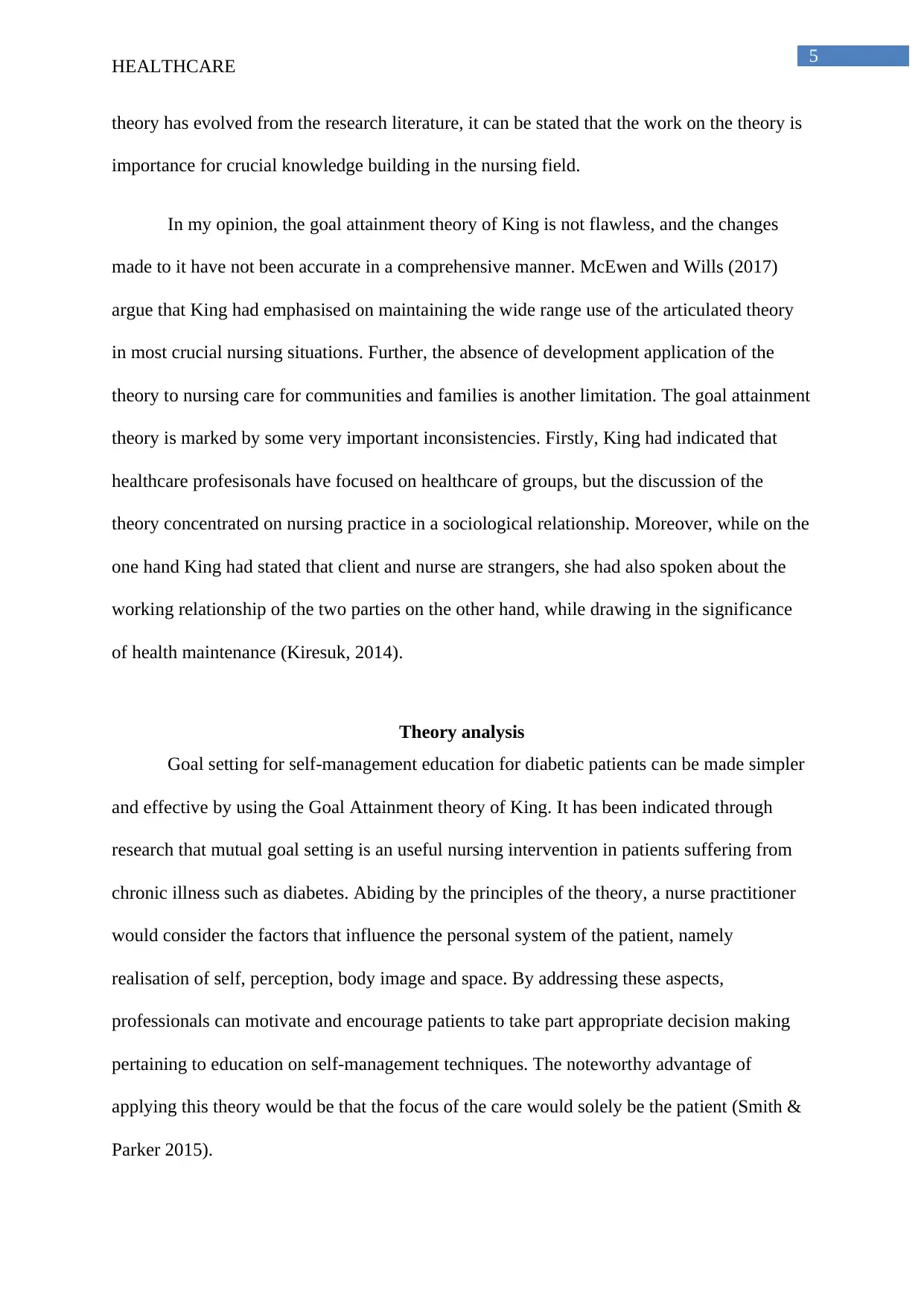
5
HEALTHCARE
theory has evolved from the research literature, it can be stated that the work on the theory is
importance for crucial knowledge building in the nursing field.
In my opinion, the goal attainment theory of King is not flawless, and the changes
made to it have not been accurate in a comprehensive manner. McEwen and Wills (2017)
argue that King had emphasised on maintaining the wide range use of the articulated theory
in most crucial nursing situations. Further, the absence of development application of the
theory to nursing care for communities and families is another limitation. The goal attainment
theory is marked by some very important inconsistencies. Firstly, King had indicated that
healthcare profesisonals have focused on healthcare of groups, but the discussion of the
theory concentrated on nursing practice in a sociological relationship. Moreover, while on the
one hand King had stated that client and nurse are strangers, she had also spoken about the
working relationship of the two parties on the other hand, while drawing in the significance
of health maintenance (Kiresuk, 2014).
Theory analysis
Goal setting for self-management education for diabetic patients can be made simpler
and effective by using the Goal Attainment theory of King. It has been indicated through
research that mutual goal setting is an useful nursing intervention in patients suffering from
chronic illness such as diabetes. Abiding by the principles of the theory, a nurse practitioner
would consider the factors that influence the personal system of the patient, namely
realisation of self, perception, body image and space. By addressing these aspects,
professionals can motivate and encourage patients to take part appropriate decision making
pertaining to education on self-management techniques. The noteworthy advantage of
applying this theory would be that the focus of the care would solely be the patient (Smith &
Parker 2015).
HEALTHCARE
theory has evolved from the research literature, it can be stated that the work on the theory is
importance for crucial knowledge building in the nursing field.
In my opinion, the goal attainment theory of King is not flawless, and the changes
made to it have not been accurate in a comprehensive manner. McEwen and Wills (2017)
argue that King had emphasised on maintaining the wide range use of the articulated theory
in most crucial nursing situations. Further, the absence of development application of the
theory to nursing care for communities and families is another limitation. The goal attainment
theory is marked by some very important inconsistencies. Firstly, King had indicated that
healthcare profesisonals have focused on healthcare of groups, but the discussion of the
theory concentrated on nursing practice in a sociological relationship. Moreover, while on the
one hand King had stated that client and nurse are strangers, she had also spoken about the
working relationship of the two parties on the other hand, while drawing in the significance
of health maintenance (Kiresuk, 2014).
Theory analysis
Goal setting for self-management education for diabetic patients can be made simpler
and effective by using the Goal Attainment theory of King. It has been indicated through
research that mutual goal setting is an useful nursing intervention in patients suffering from
chronic illness such as diabetes. Abiding by the principles of the theory, a nurse practitioner
would consider the factors that influence the personal system of the patient, namely
realisation of self, perception, body image and space. By addressing these aspects,
professionals can motivate and encourage patients to take part appropriate decision making
pertaining to education on self-management techniques. The noteworthy advantage of
applying this theory would be that the focus of the care would solely be the patient (Smith &
Parker 2015).
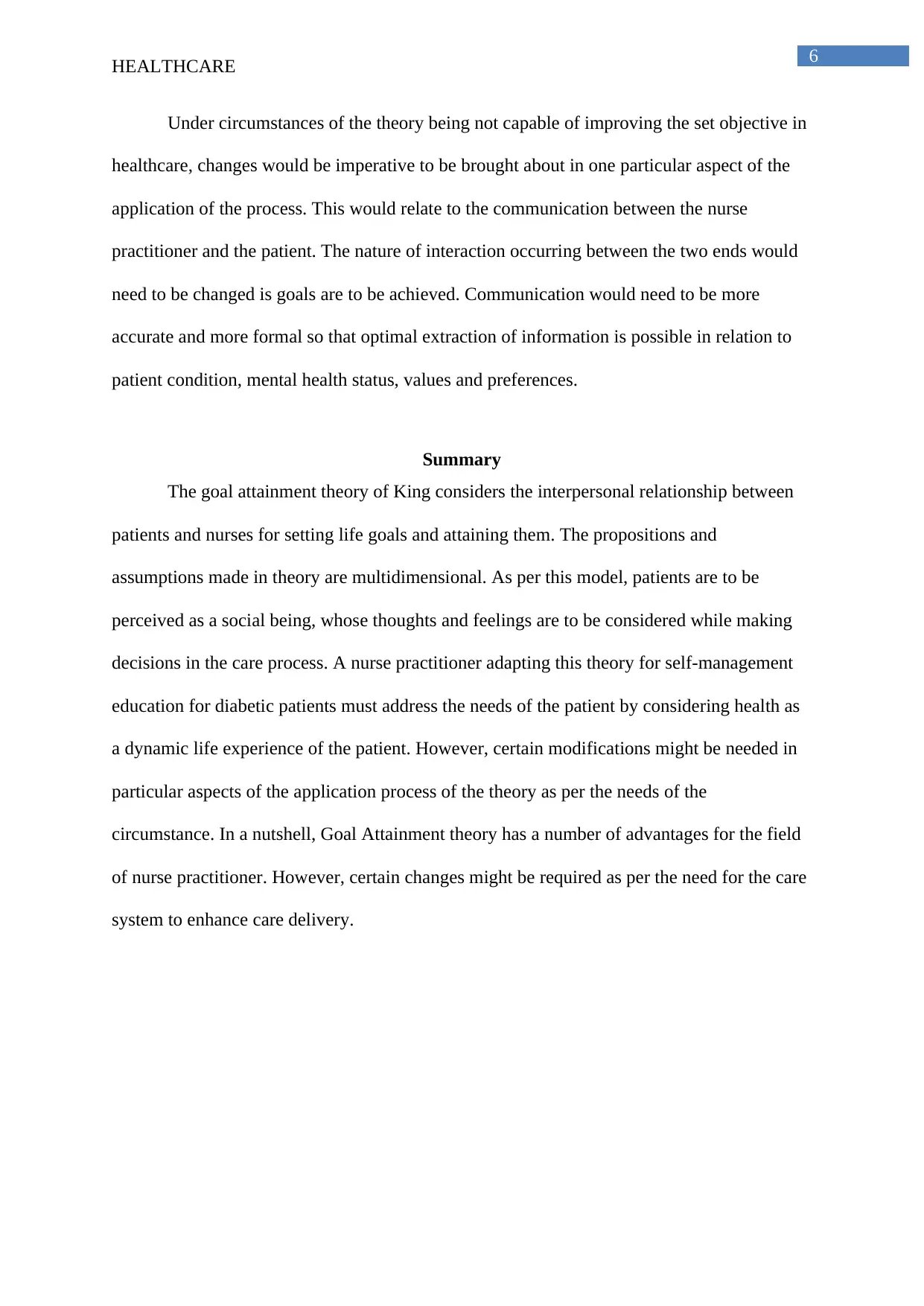
6
HEALTHCARE
Under circumstances of the theory being not capable of improving the set objective in
healthcare, changes would be imperative to be brought about in one particular aspect of the
application of the process. This would relate to the communication between the nurse
practitioner and the patient. The nature of interaction occurring between the two ends would
need to be changed is goals are to be achieved. Communication would need to be more
accurate and more formal so that optimal extraction of information is possible in relation to
patient condition, mental health status, values and preferences.
Summary
The goal attainment theory of King considers the interpersonal relationship between
patients and nurses for setting life goals and attaining them. The propositions and
assumptions made in theory are multidimensional. As per this model, patients are to be
perceived as a social being, whose thoughts and feelings are to be considered while making
decisions in the care process. A nurse practitioner adapting this theory for self-management
education for diabetic patients must address the needs of the patient by considering health as
a dynamic life experience of the patient. However, certain modifications might be needed in
particular aspects of the application process of the theory as per the needs of the
circumstance. In a nutshell, Goal Attainment theory has a number of advantages for the field
of nurse practitioner. However, certain changes might be required as per the need for the care
system to enhance care delivery.
HEALTHCARE
Under circumstances of the theory being not capable of improving the set objective in
healthcare, changes would be imperative to be brought about in one particular aspect of the
application of the process. This would relate to the communication between the nurse
practitioner and the patient. The nature of interaction occurring between the two ends would
need to be changed is goals are to be achieved. Communication would need to be more
accurate and more formal so that optimal extraction of information is possible in relation to
patient condition, mental health status, values and preferences.
Summary
The goal attainment theory of King considers the interpersonal relationship between
patients and nurses for setting life goals and attaining them. The propositions and
assumptions made in theory are multidimensional. As per this model, patients are to be
perceived as a social being, whose thoughts and feelings are to be considered while making
decisions in the care process. A nurse practitioner adapting this theory for self-management
education for diabetic patients must address the needs of the patient by considering health as
a dynamic life experience of the patient. However, certain modifications might be needed in
particular aspects of the application process of the theory as per the needs of the
circumstance. In a nutshell, Goal Attainment theory has a number of advantages for the field
of nurse practitioner. However, certain changes might be required as per the need for the care
system to enhance care delivery.
⊘ This is a preview!⊘
Do you want full access?
Subscribe today to unlock all pages.

Trusted by 1+ million students worldwide
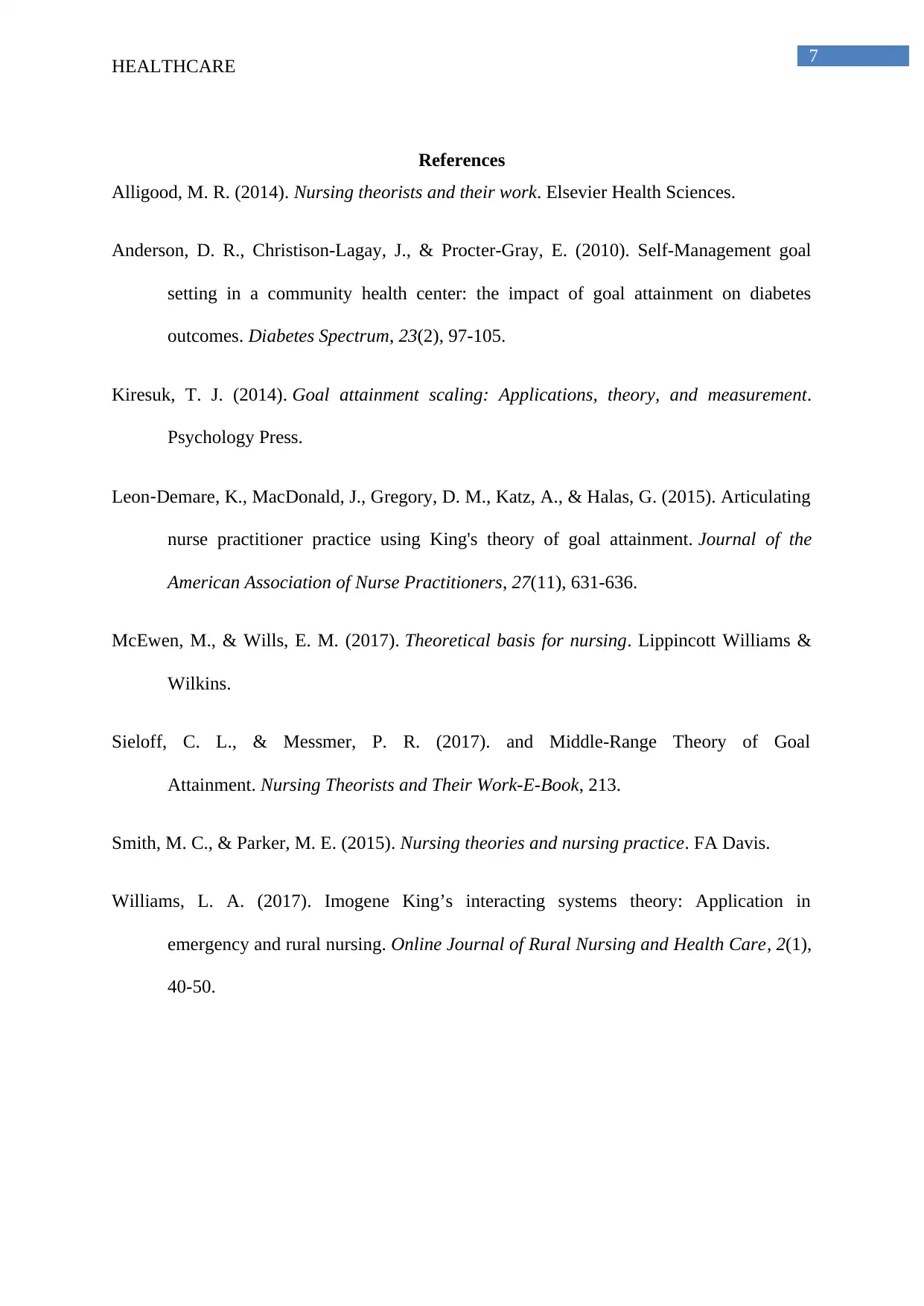
7
HEALTHCARE
References
Alligood, M. R. (2014). Nursing theorists and their work. Elsevier Health Sciences.
Anderson, D. R., Christison-Lagay, J., & Procter-Gray, E. (2010). Self-Management goal
setting in a community health center: the impact of goal attainment on diabetes
outcomes. Diabetes Spectrum, 23(2), 97-105.
Kiresuk, T. J. (2014). Goal attainment scaling: Applications, theory, and measurement.
Psychology Press.
Leon‐Demare, K., MacDonald, J., Gregory, D. M., Katz, A., & Halas, G. (2015). Articulating
nurse practitioner practice using King's theory of goal attainment. Journal of the
American Association of Nurse Practitioners, 27(11), 631-636.
McEwen, M., & Wills, E. M. (2017). Theoretical basis for nursing. Lippincott Williams &
Wilkins.
Sieloff, C. L., & Messmer, P. R. (2017). and Middle-Range Theory of Goal
Attainment. Nursing Theorists and Their Work-E-Book, 213.
Smith, M. C., & Parker, M. E. (2015). Nursing theories and nursing practice. FA Davis.
Williams, L. A. (2017). Imogene King’s interacting systems theory: Application in
emergency and rural nursing. Online Journal of Rural Nursing and Health Care, 2(1),
40-50.
HEALTHCARE
References
Alligood, M. R. (2014). Nursing theorists and their work. Elsevier Health Sciences.
Anderson, D. R., Christison-Lagay, J., & Procter-Gray, E. (2010). Self-Management goal
setting in a community health center: the impact of goal attainment on diabetes
outcomes. Diabetes Spectrum, 23(2), 97-105.
Kiresuk, T. J. (2014). Goal attainment scaling: Applications, theory, and measurement.
Psychology Press.
Leon‐Demare, K., MacDonald, J., Gregory, D. M., Katz, A., & Halas, G. (2015). Articulating
nurse practitioner practice using King's theory of goal attainment. Journal of the
American Association of Nurse Practitioners, 27(11), 631-636.
McEwen, M., & Wills, E. M. (2017). Theoretical basis for nursing. Lippincott Williams &
Wilkins.
Sieloff, C. L., & Messmer, P. R. (2017). and Middle-Range Theory of Goal
Attainment. Nursing Theorists and Their Work-E-Book, 213.
Smith, M. C., & Parker, M. E. (2015). Nursing theories and nursing practice. FA Davis.
Williams, L. A. (2017). Imogene King’s interacting systems theory: Application in
emergency and rural nursing. Online Journal of Rural Nursing and Health Care, 2(1),
40-50.
1 out of 7
Related Documents
Your All-in-One AI-Powered Toolkit for Academic Success.
+13062052269
info@desklib.com
Available 24*7 on WhatsApp / Email
![[object Object]](/_next/static/media/star-bottom.7253800d.svg)
Unlock your academic potential
Copyright © 2020–2025 A2Z Services. All Rights Reserved. Developed and managed by ZUCOL.





